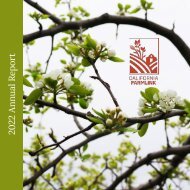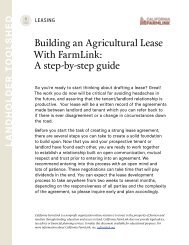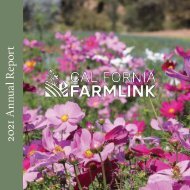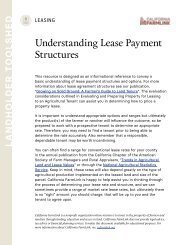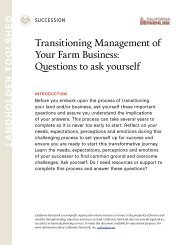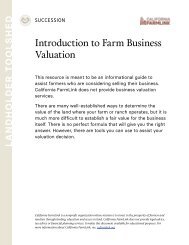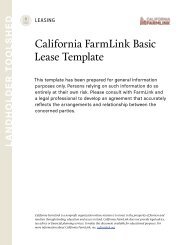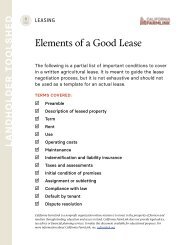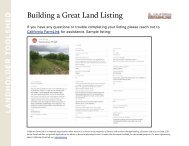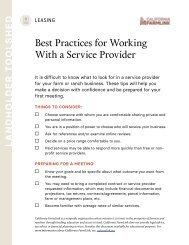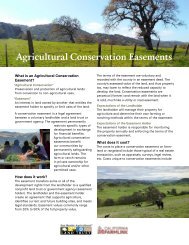Guide to Regenerative Grazing Leases: Opportunities for Resilience
California FarmLink and TomKat Ranch Educational Foundation teamed up to create this resource focused on land leases that support regenerative grazing practices. This guidebook aims to empower private, nonprofit, and public landholders, as well as easement-holders and grazing tenants.
California FarmLink and TomKat Ranch Educational Foundation teamed up to create this resource focused on land leases that support regenerative grazing practices. This guidebook aims to empower private, nonprofit, and public landholders, as well as easement-holders and grazing tenants.
Create successful ePaper yourself
Turn your PDF publications into a flip-book with our unique Google optimized e-Paper software.
CHAPTER 4. In<strong>to</strong> the Next Generation (Continued)<br />
RANCHES IN TRANSITION<br />
Average age:<br />
• Average age of the American farmer/rancher is approximately 58 years, with<br />
a full third of agricultural opera<strong>to</strong>rs over 65 years old. Ranchers/lives<strong>to</strong>ck<br />
opera<strong>to</strong>rs appear <strong>to</strong> be slightly younger on average.<br />
Rangeland in transition:<br />
• The number of acres of grazing lands predicted <strong>to</strong> change hands in the next 25<br />
years is estimated in the hundreds of millions. Most of this land will be passed<br />
down within families.<br />
Proportion of grazing lands leased vs. owned by ranchers:<br />
• Nearly 30% of US grazing lands are leased.<br />
Landholder & rancher diversity:<br />
• 98% of the agricultural lands in the US are white-owned.* Approximately 73%<br />
of all US ranchers (employees as well as business owners) are white.† The<br />
proportion of female ranchers has also grown slightly over the past ten years <strong>to</strong><br />
approximately 29% of all ranchers.<br />
Pho<strong>to</strong>: Liya Schwartzman<br />
*According <strong>to</strong> census data.<br />
†Union of Concerned Scientists, HEAL Food Alliance. Leveling the Fields: Creating<br />
Farming <strong>Opportunities</strong> <strong>for</strong> Black People, Indigenous People, and Other People of Color.<br />
ACKNOWLEDGING LAND AND POWER<br />
Know thy land. When embarking on your regenerative management journey, start with<br />
the land and the opportunity be<strong>for</strong>e you. How has the land been managed his<strong>to</strong>rically<br />
(who are its indigenous ances<strong>to</strong>rs?) and through recent times? How has this<br />
impacted the landscape and ecosystem? How many acres are grazeable and what<br />
infrastructure—barns, corrals, sheds, fencing—are available? What is the quality of<br />
the grazing lands, and what is biotically unique in the landscape? How does water<br />
move across the landscape, and what is the water infrastructure like? Who are your<br />
regenerative or holistic range management advisors? Is the property listed under the<br />
Williamson Act or encumbered by any other conservation, agricultural, or right-of-way<br />
easement? A deep knowledge, and detailed description, of the land opportunity is the<br />
first step <strong>to</strong> finding the best fit in a lessee.<br />
© Copyright 2022 Cali<strong>for</strong>nia FarmLink and TomKat Ranch Educational Foundation<br />
44



